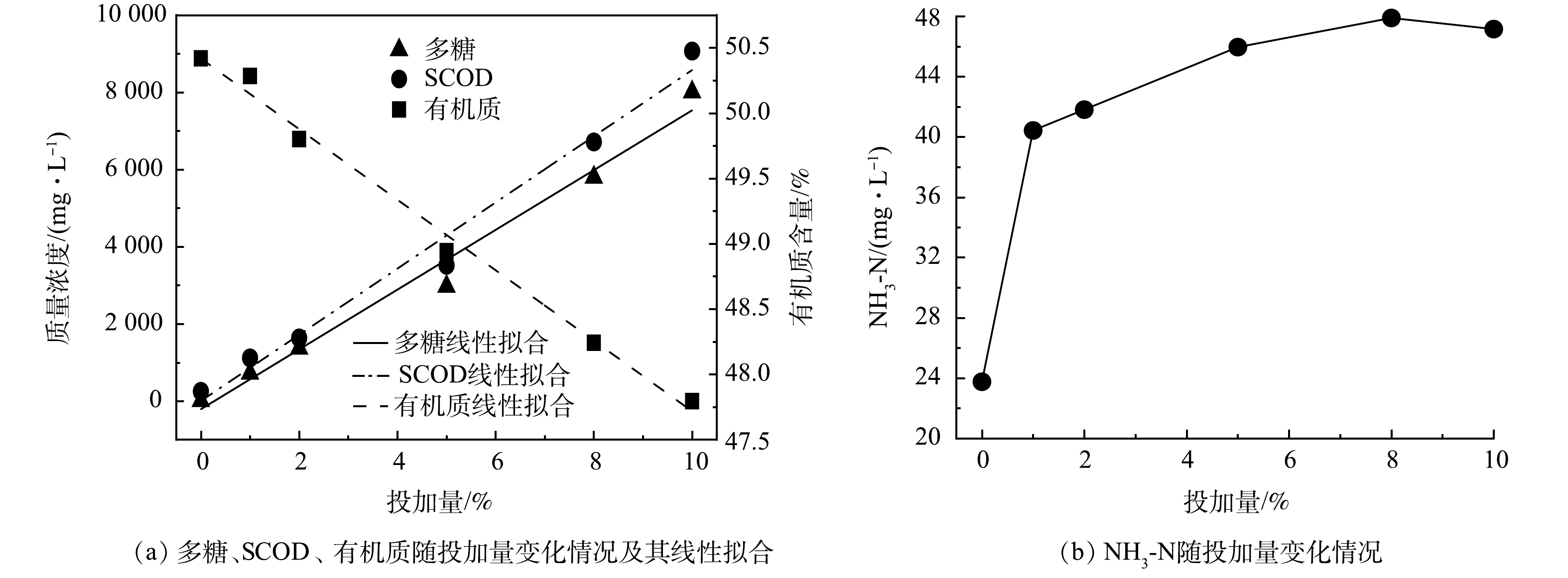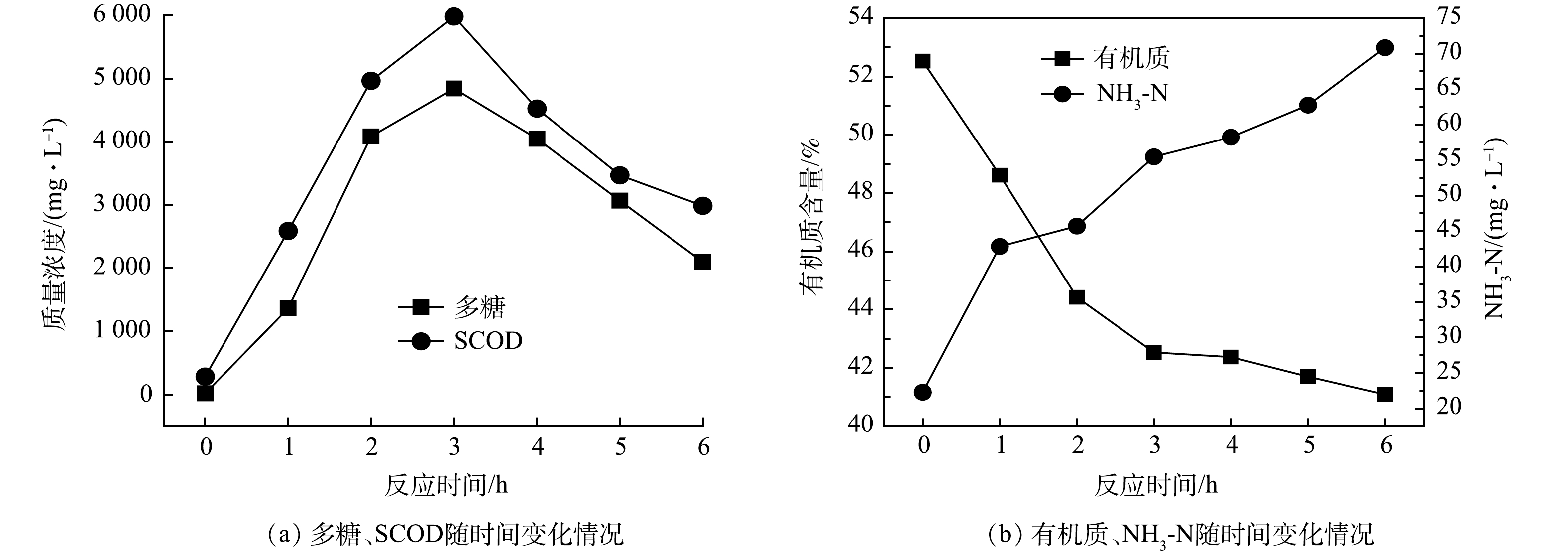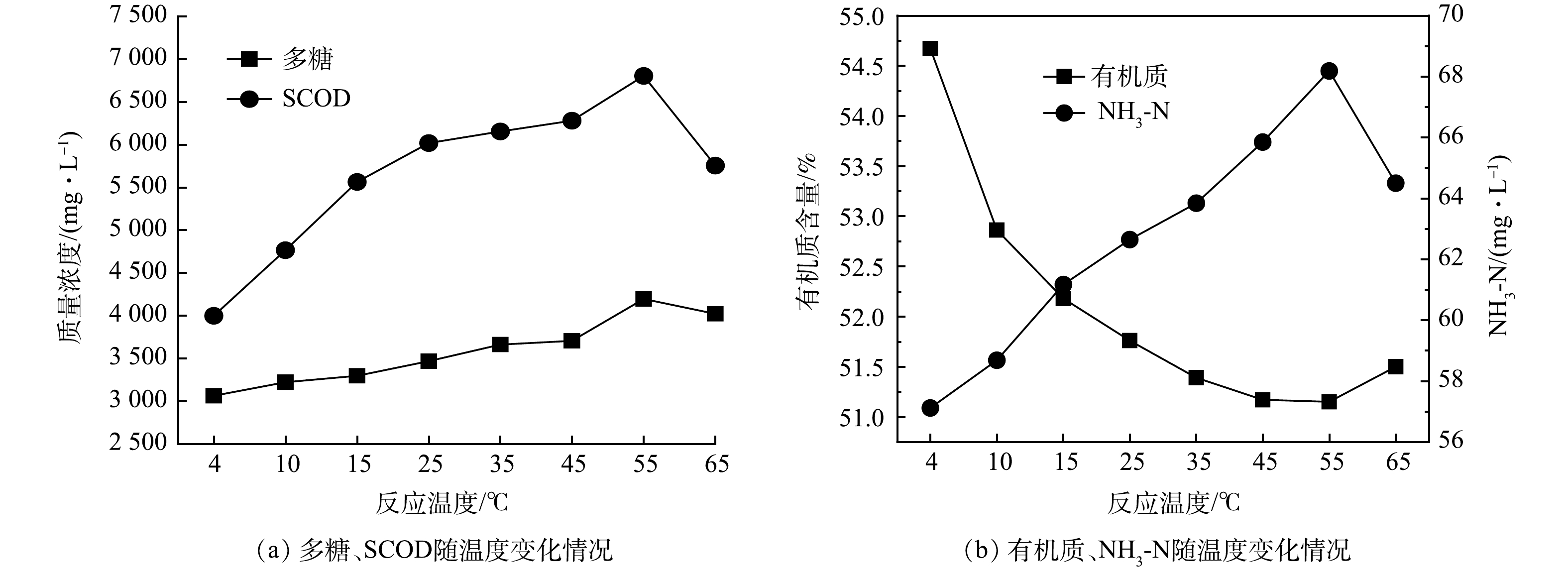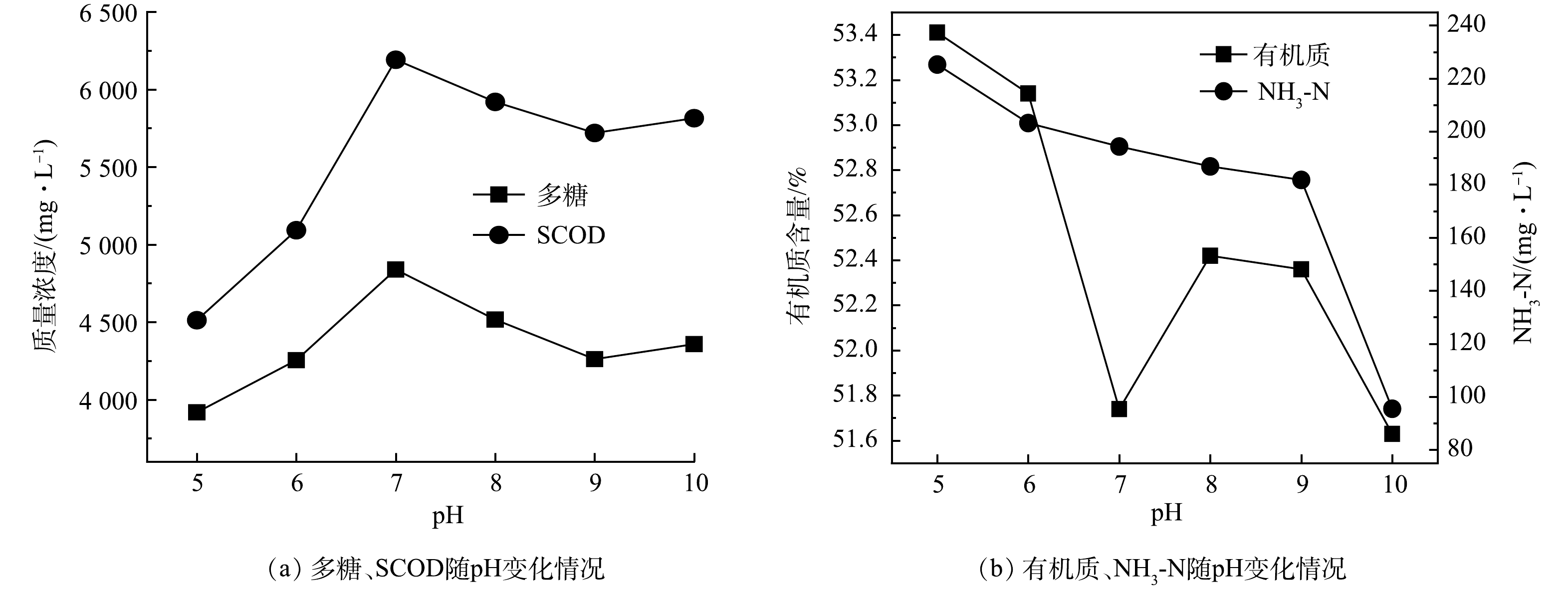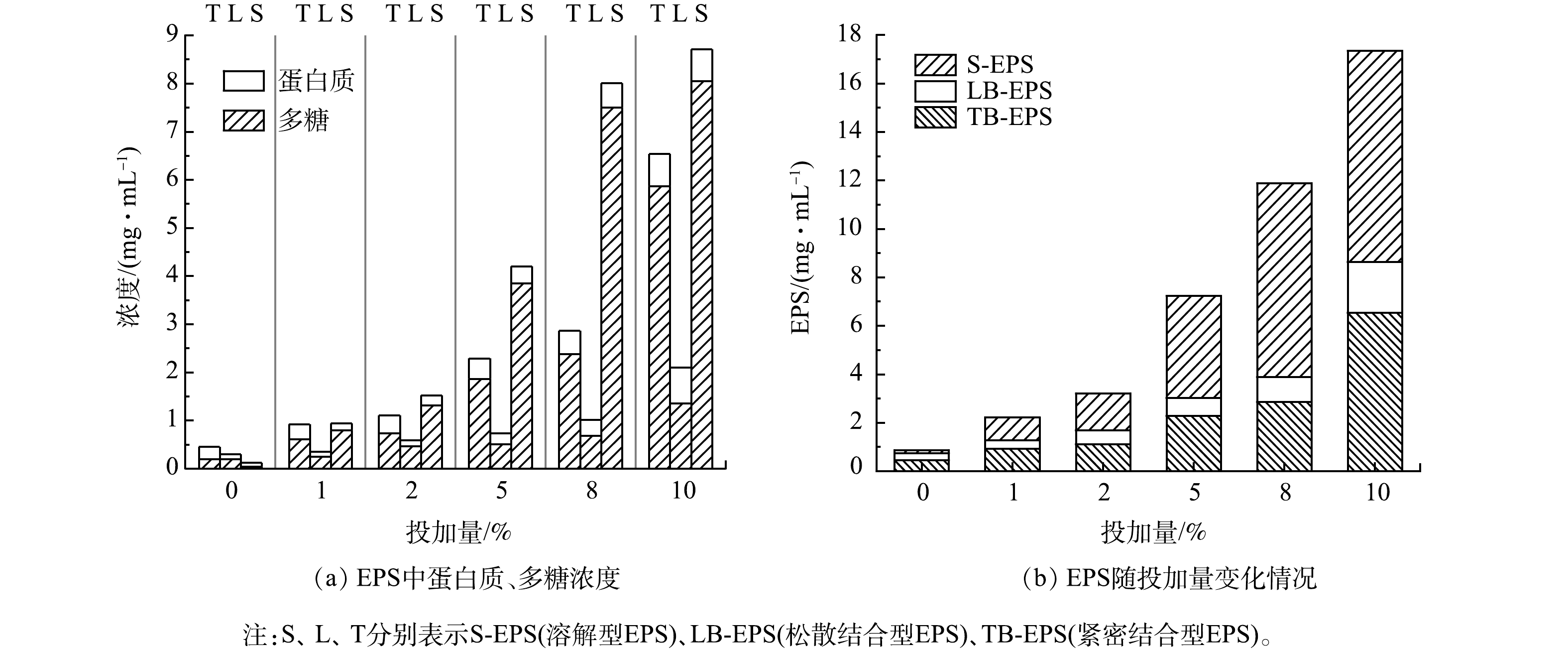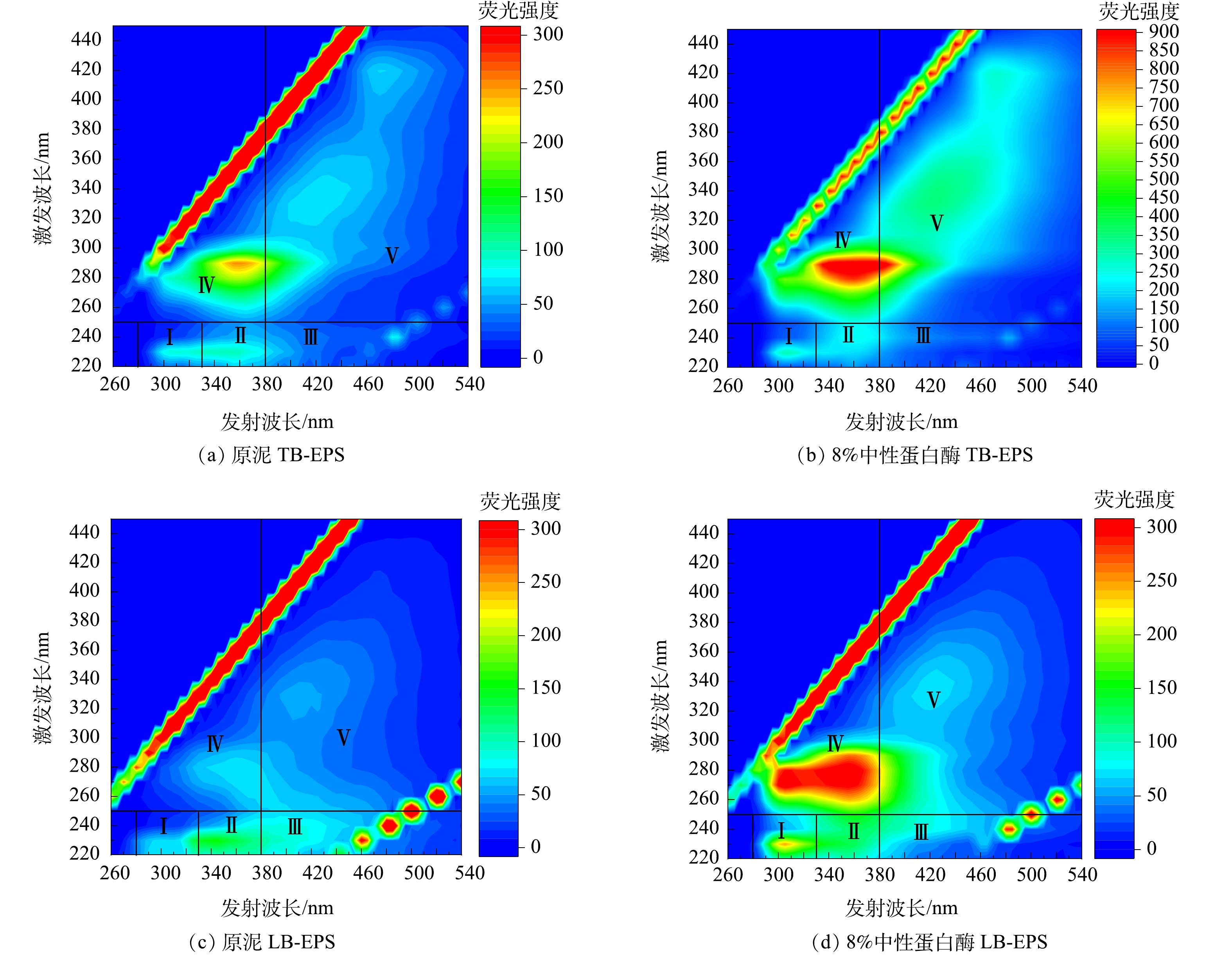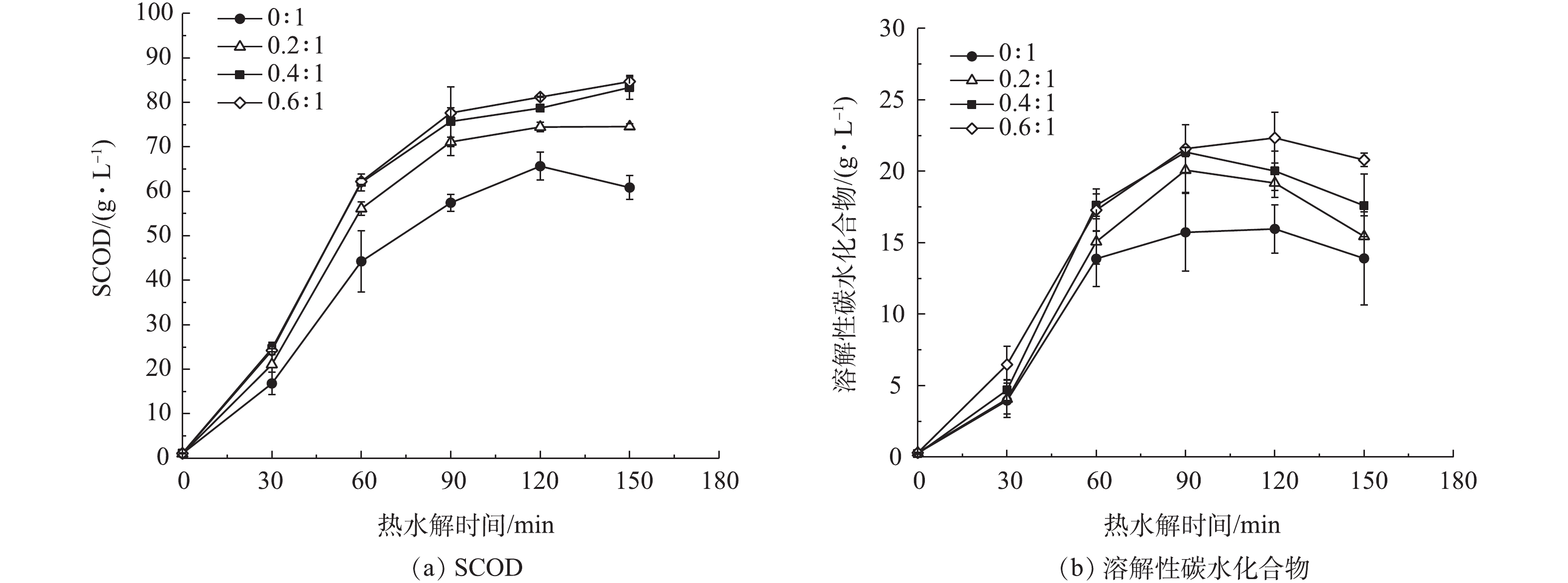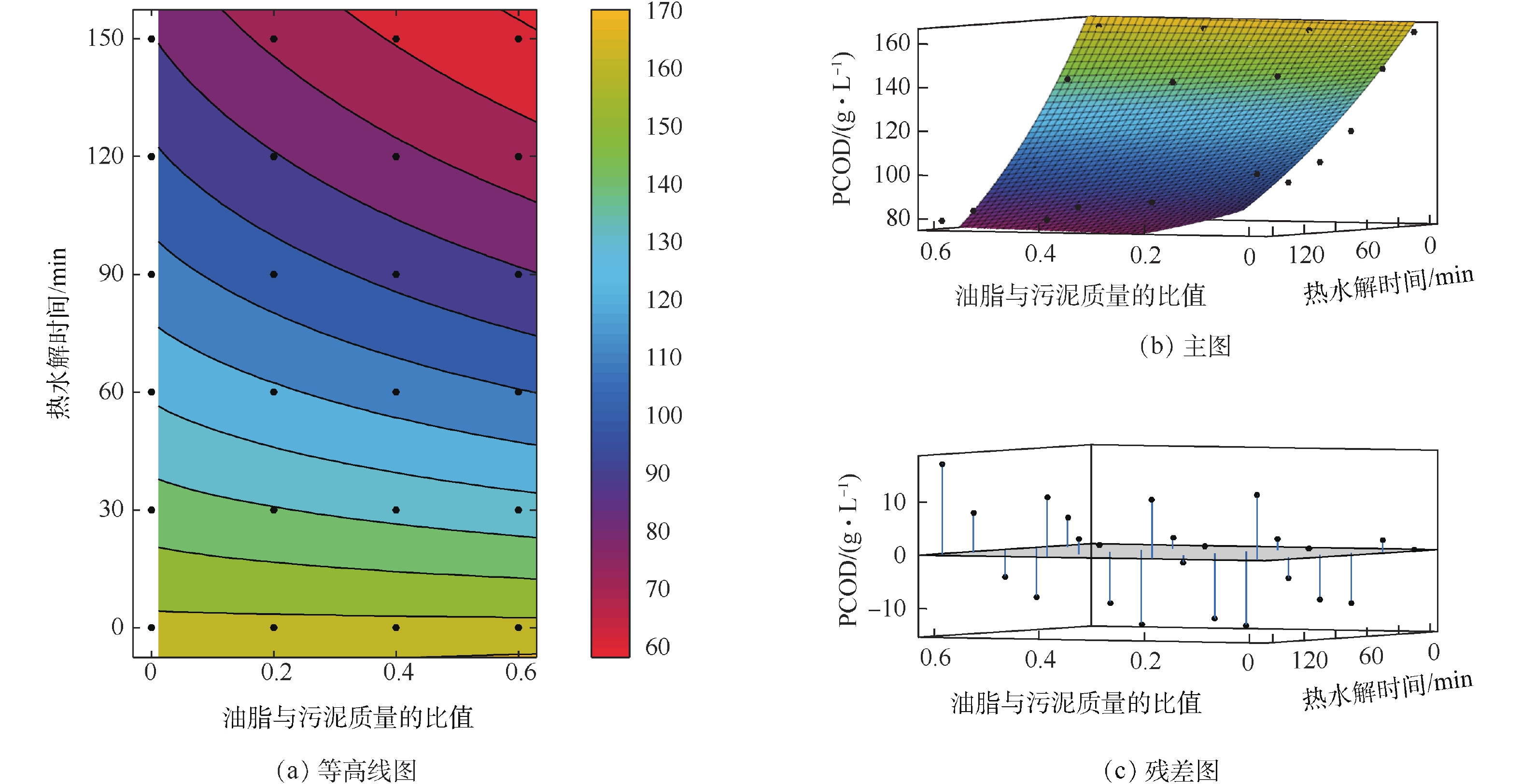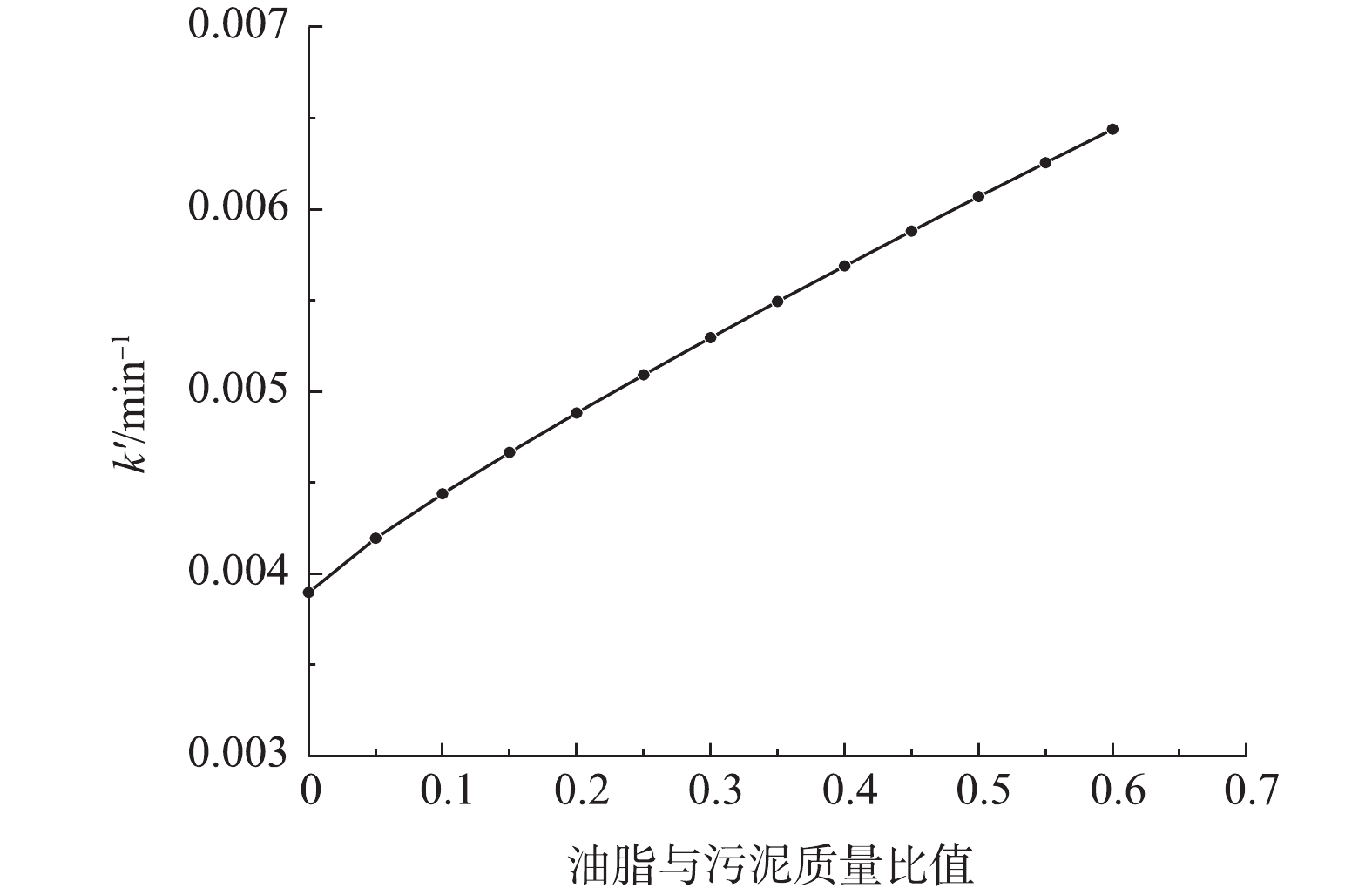-
城市污水处理厂污泥成分复杂,含有大量病原菌、重金属、有机污染物等有毒有害物质[1],其安全处理对生态环境和人类健康至关重要。厌氧消化被认为是一种经济且环境友好的污泥处理技术[2],但存在沼气产率低、消化池体积庞大等问题[3]。高含固污泥厌氧消化(含固率大于10%)可有效提高消化池有机负荷和消化效率,缩小设备体积[4],通过与热水解预处理技术组合,以加速污泥水解,提高甲烷产量[5],实现污泥的高效、低成本处理。但是当污泥的含固率提高时,其导热系数会随之降低[6],热水解能耗将显著增加,特别是当污泥含固率达到15%及以上时,污泥颗粒孔隙中可能存在空气,将明显降低污泥导热能力[7]。马俊伟等[8]研究表明,随着污泥含固率的提高,污泥的传热性能减弱,使得热水解过程中有机物溶解率下降,沼气产率明显降低。在提升污泥含固率时,污泥热水解效率降低,时间延长,将显著影响高含固污泥热水解-厌氧消化工艺的能量平衡。
餐厨油脂是伴随餐厨垃圾产生的一种有机废弃物,我国餐厨垃圾中油脂含量普遍较高,据报道,青岛等地的餐厨垃圾中油脂占了25.30%,重庆、四川等地由于火锅类所占比例较大,油脂约占餐厨垃圾的29.70%[9]。餐厨油脂是一种较好的导热介质,其导热系数远远大于空气,张玉珂[10]测定了5种食用油的导热系数,当温度为100~200 ℃时,油脂的导热系数为0.20~0.23 W·(m·K)−1,而空气的导热系数仅为0.01~0.02 W·(m·K)−1[11]。此外,油脂在高温下(>120 ℃)发生的对流传热会进一步加快热量传递[12]。含固率大于15%的污泥颗粒中存在空气,导热能力显著降低,将油脂与高含固污泥混合进行热水解,可以利用油脂良好的导热性能促进热量传递,提高热水解效率。同时,油脂也是一种理想的共消化基质,其单位质量的沼气产量和甲烷产量比碳水化合物和蛋白质高[13]。污泥与油脂共消化可平衡营养、改善碳氮比、稀释抑制性物质,提高厌氧消化系统的稳定性和甲烷产量[14]。
本研究针对高含固污泥传热性能下降的问题,向含固率大于15%的污泥中加入适量餐厨油脂进行热水解,探讨油脂促进并加速污泥热水解的可行性,同时通过厌氧消化实验得到最佳条件,为污泥的高效处理提供参考。
全文HTML
-
实验污泥取自西安市某污水处理厂剩余污泥,该污水厂采用A2/O工艺,将污泥脱水至含固率为15%左右后,置于4 ℃冰箱保存待用,污泥的特性如下:TS (150.50±2.65) g·L−1,VS (105.65±2.12) g·L−1,TCOD (163.77±4.28) g·L−1,SCOD (1.06±0.17) g·L−1,总碳水化合物(49.22±0.37) g·L−1,溶解性碳水化合物(0.28±0.04) g·L−1,总蛋白质(71.97±8.95) g·L−1,溶解性蛋白质(0.25±0.04) g·L−1,氨氮(0.12±0.02) g·L−1。实验接种泥取自稳定运行200 d以上的高含固中温厌氧消化反应器的消化液,温度为(35±1) ℃。实验中所用餐厨油脂为某品牌火锅底料,加水煮沸,冷却后提取上层油脂,油脂在常温下为固态,餐厨油脂的TS为(984.56±2.50) g·L−1,VS为(981.45±2.55) g·L−1。
-
实验装置包含热水解预处理装置和厌氧消化实验装置。热水解预处理装置由压力反应容器和加热设备组成:压力反应容器为KH-200型圆柱形消解罐,反应罐的罐体采用不锈钢制成,内衬为聚四氟乙烯消解罐(200 mL有效容积),工作温度<250 ℃、工作压力<3.0 MPa;加热设备为国华HH-S数显恒温油浴锅,配置2套温度检测系统,加热介质为二甲基硅油。厌氧消化实验装置包括恒温振荡器和厌氧消化反应器:恒温振荡器为国华SHA-C型恒温振荡器;厌氧消化反应器包括反应瓶、集气瓶和气体体积测量瓶,采用排水集气法测定产气量。
-
1)热水解实验。为了探究油脂对污泥热水解的影响,开展了不同餐厨油脂与高含固污泥比例下的热水解实验,测定污泥热水解前、后的溶解态指标。餐厨油脂与污泥的质量比分别为0.2∶1、0.4∶1、0.6∶1。有研究表明热水解的最适温度为160~170 ℃[15-17],本研究的热水解温度设置为165 ℃。取100 g混合样品置于消解罐内放入恒温油浴锅,分别计时0、30、60、90、120、150 min,加热结束后,将消解罐自然冷却至室温,取出样品置于4 ℃冰箱保存待用。实验设计见表1。
2)厌氧消化实验。为了探究不同预处理条件对厌氧消化性能的影响,进行厌氧消化批次实验。将一定质量的热水解样品置于100 mL 血清瓶中,加入50 mL接种泥,接种泥与样品的VS比为2∶1,同时取50 mL接种泥做空白样,每个样品设置3个平行。用1 mol·L−1 NaOH和1 mol·L−1 HCl调节初始pH在7.2左右,向瓶中加入1 mL的2 g·L−1 NaHCO3缓冲溶液,瓶子的顶部空间用高纯氮气冲洗约2 min,随后迅速用橡胶塞密封瓶口。将连接好气路的反应瓶置于(35±1) ℃的恒温振荡器中进行培养,持续时间30 d,每日测量沼气产量,通过测定气体组分确定沼气中的甲烷含量。
-
实验所测指标包括TS、VS、COD、氨氮、碳水化合物、蛋白质和沼气组分。TS、VS采用标准重量法测定;COD采用重铬酸钾法测定;氨氮采用纳氏试剂分光光度法测定;碳水化合物采用苯酚-硫酸法[18]测定,以葡萄糖为标准样品;蛋白质采用Folin-酚法[19]测定,以牛血清蛋白为标准样品;沼气组分通过气相色谱仪(BEIFEN Corp.3420A)测定,TCD检测器、TDX-01填充柱,进样口温度为100 ℃,柱箱温度为80 ℃,检测器温度为100 ℃。
1.1. 实验污泥与油脂
1.2. 实验装置
1.3. 实验方法
1.4. 测定指标及方法
-
热水解预处理可以促使污泥中固体有机物的水解,使得溶解态有机物增加。为了分析热水解时间和油脂与污泥质量比对污泥热水解效率的影响,测定了污泥热水解前、后的溶解态指标。
1)SCOD和溶解性碳水化合物的变化。热水解时间和油脂与污泥质量比对污泥中SCOD和溶解性碳水化合物的影响见图1。由图1可知,当热水解时间从0 min增至90 min的过程中,污泥中的SCOD与溶解性碳水化合物显著升高;热水解时间从90 min增至150 min时,SCOD基本趋于平稳,溶解性碳水化合物反而降低,这可能由于一些溶解态的有机物进一步分解为挥发性脂肪酸[20]。陈汉龙等[21]研究了温和热处理(常压,100 ℃)对低有机质污泥(VS/TS<50%)有机物溶出的影响,结果表明,热水解后污泥中SCOD与溶解态碳水化合物增加,且随着热水解时间的延长,其呈现先增加后趋于平缓的趋势。与对照组相比,添加油脂的污泥经过热水解后,其细胞中SCOD和溶解性碳水化合物的释放量均增加,表明油脂可以促进不溶态有机物的水解。热水解时间为90 min,油脂与污泥的质量比从0.2∶1增加至0.4∶1时,相比未添加油脂的污泥,SCOD分别增加了23.85%±1.91%和31.85%±5.12%,溶解性碳水化合物分别增加了27.64%±8.03%和35.72%±2.14%,当进一步提高油脂的比例时,溶解态有机物的增加并不明显。
2)溶解性蛋白质和氨氮的变化。蛋白质也是污泥有机物的主要成分,热水解可以促进不溶态蛋白质的溶解,同时加快可溶性蛋白质的变性,进而导致其分解为氨氮。污泥中溶解性蛋白质和氨氮的测定结果见图2。由图2(a)可知,溶解性蛋白质的变化规律与SCOD和溶解性碳水化合物类似,在90 min前有显著增加,90 min后基本不变。随着油脂比例的增加,溶解性蛋白质先增加后趋于稳定,当热水解时间为90 min时,油脂与污泥质量比从0.2∶1增加至0.6∶1时,相比对照组,溶解性蛋白质分别增加了19.97%±2.11%、41.39%±5.38%和45.58%±4.24%。由图2(b)可知,当热水解时间从0 min增至90 min时,氨氮的增加量较多,其后,氨氮的增加不明显。程瑶等[15]研究了热水解对高含固污泥特性的影响,结果表明,氨氮浓度随热水解时间的延长逐渐增大,当时间大于50 min时,增幅不大,这表明原泥中可以转化为氨氮的蛋白质已基本转化为氨氮。相比对照组,添加油脂后污泥中的氨氮增加较多,这表明油脂可以促进溶解性蛋白质的进一步水解。当油脂与污泥的质量比达到0.4∶1时,氨氮增加较多,再增加油脂的比例,氨氮变化不大。当热水解时间为90 min时,油脂与污泥的质量比分别为0.2∶1、0.4∶1、0.6∶1,相比未添加油脂的污泥,氨氮分别增加了1.48%±0.21%、58.56%±5.62%、69.30%±1.09%。
-
为了探究油脂对热水解速率的影响,进行了污泥热水解动力学分析。污泥中颗粒态有机物(PCOD)的减少可以反映热水解的效果。一级动力学方程可以描述有机物的水解过程,方程[22]见式(1),假设油脂影响污泥的热水解速率,则添加油脂后水解速率常数为
k′ ,计算方法如式(2)所示。式中:CPCOD为污泥中PCOD的浓度,g·L−1;t为热水解时间,min;k为未添加油脂时PCOD的水解速率常数,min−1;
k′ 为添加油脂后PCOD的水解速率常数,min−1;Rgrease为油脂与污泥质量的比值;a为常数。根据模型对污泥热水解后的CPCOD值进行拟合,得到了拟合曲面图(R2=0.918 7)(见图3)。由图3可知,随着热水解时间的延长和油脂比例的增高,污泥中的不溶态有机物减少,相比热水解时间,油脂比例对不溶态有机物溶解的影响较小。当热水解时间小于60 min时,增加油脂的比例对PCOD的变化影响较小,这表明在60 min之内,油脂对热水解的影响不大;当热水解时间达到90 min时,随着油脂比例的增加,PCOD的减少较明显,此时,油脂对热水解的影响程度较为显著。
拟合后得到式(1)和式(2)中k、a的值分别为0.004、0.902,则添加油脂后有机物水解速率常数
k′ 的值可由式(3)表示。通过计算
k′ 值分析油脂对污泥水解速率的影响。k′ 随油脂比例的变化见图4。由图4可知,油脂影响有机物的水解速率,随着油脂比例的增加,k′ 值升高,有机物的水解速率提高。通过计算k′ /k可知,当油脂与污泥的质量比为0.2∶1、0.4∶1、0.6∶1时,PCOD的水解速率分别提高了23.30%、43.63%和62.98%。有机物的水解速率提高,所需的加热时间便可缩短,未添加油脂时,污泥中不溶态有机物的水解率最高为39.70%,此时,热水解时间为120 min,在此水解率下,当油脂与污泥的质量比为0.2∶1、0.4∶1、0.6∶1时,热水解时间可分别缩短至102、88和78 min。 -
热水解可以促进污泥中不溶态有机物的水解,为后续厌氧消化提供更多易降解的基质,同时,油脂的存在会影响厌氧消化性能。为了评估热水解后样品的厌氧消化性能,并进一步验证油脂添加对热水解过程的促进作用,开展了厌氧消化批次实验。对实验前后的pH进行测定以表征实验前后系统的稳定性并反映系统的酸化状况,同时测定氨氮以反映系统的氨抑制情况。实验后各组样品的pH由7.20±0.12上升至7.40±0.13,这表明实验过程中,厌氧消化环境稳定且没有发生酸化现象;实验后各组样品的游离氮浓度为(51.80±11.93) mg·L−1,远低于氨抑制阈值[23]。因此,厌氧消化过程稳定,未发生抑制现象。
为了分析基质厌氧消化的产甲烷潜力、产甲烷速率和产甲烷延滞情况,采用修正的Gompertz方程对累积甲烷产量进行模拟[24],方程见式(4)。
式中:Mt为t时单位质量VS的累积甲烷产量,mL·g−1;Mmax为单位质量VS的最大产甲烷潜力,mL·g−1;Rmax为单位质量VS的最大产甲烷速率,mL·(g·d)−1;λ为延滞期,d;t为厌氧消化实验的持续时间,d;e为2.718 3。
不同条件下的累积甲烷产量见图5。由图5(a)可知,未添加油脂时,当热水解时间从0 min增加至90 min时,甲烷产量亦随之增加,热水解时间为90 min时,累积甲烷产量最大,为267 mL·g−1。通过拟合得到Mmax值,对未添加油脂时不同热水解时间下的Mmax值进行单因素方差分析,显著因子为0.05,这表明热水解时间对最大甲烷产量有显著影响(P=1.8×10−3)。其主要原因是,热水解促进了不溶态有机物的水解,增加了污泥中可降解基质的量,使得甲烷产量增加。对比图5(a)与图5(b)、图5(c)、图5(d)可知,添加油脂后,甲烷产量显著增加,这也证实了油脂相比蛋白质和碳水化合物有更高的产甲烷潜力。未添加油脂时,最高甲烷产量为267 mL·g−1,添加油脂后,甲烷产量增加了2.30~3.32倍。KABOURIS等[25]研究了油脂与市政污泥的共消化结果,得出共消化的最终甲烷产量比污泥单独厌氧消化时增加了2.95倍。当油脂与污泥的质量比从0.2:1增加至0.4∶1时,不同热水解时间下的最终甲烷产量从615~733 mL·g−1增加至725~886 mL·g−1,当油脂与污泥的质量比达到0.6∶1时,甲烷产量与其比例为0.4∶1时的结果类似,虽然甲烷产量还有上升的趋势,但随着厌氧消化时间的延长,所需的能耗也会有所增加。
延滞期可以反映消化启动时的快慢。由图5(a)可知,污泥单独消化时能立即产生甲烷,添加油脂后(图5(b)~(d)),产气延缓,随着油脂添加量的增加,延滞时间也在延长。通过拟合得到延滞期λ的值,当油脂与污泥的质量比分别为0.2∶1、0.4∶1、0.6∶1时,不同热水解时间下的λ值分别为2.75~9.46、7.24~12.80和10.15~21.01 d。HAN等[26]研究表明,产甲烷的延滞期随长链脂肪酸(long chain fatty acids,LCFAs)初始浓度的增加呈线性增加。造成延滞期增加的原因可能来自LCFAs的抑制,在厌氧消化过程中,脂肪水解为甘油和脂肪酸能很快进行,甘油可以迅速产生沼气[27],而LCFAs的分解过程比较复杂[28],这就造成了LCFAs的积累。一方面,LCFAs对微生物细胞壁的吸附阻碍了物质运输,并会造成污泥的上浮[29];另一方面,LCFAs对产乙酸菌和产甲烷菌有毒害作用[30],微生物对LCFAs的适应必定会延长产甲烷的时间。
对最大产甲烷速率Rmax进行分析,结果表明,相比污泥单独消化,油脂和污泥协同消化的最大产甲烷速率增加。这与LIU等[31]的研究结果类似:污泥单独消化时产甲烷速率很低,添加餐厨垃圾后产甲烷速率显著增加,Rmax随着餐厨垃圾的增加逐渐增大,当基质全部为餐厨垃圾时,Rmax最大。韩芸等[32]以热水解后的高含固污泥及其脱水后固、液分离产物为对象进行厌氧消化实验,结果发现,在消化前期,脱水液的产气速率大于热水解污泥,这是因为脱水液中溶解性有机物的可生化性强于热水解污泥。因此,产甲烷速率增加的原因是由于基质的可生化性的提高。
2.1. 不同预处理条件对污泥组分的影响
2.2. 油脂协同污泥热水解的动力学分析
2.3. 热水解与油脂对厌氧消化性能的影响
-
1)油脂与污泥协同热水解可有效促进污泥中不溶态有机物的水解,污泥中溶解态物质的浓度随热水解时间与油脂比例的增加呈先增加后趋于稳定的趋势,当热水解时间为90 min、油脂与污泥的质量比为0.4∶1时,污泥中的不溶态有机物水解充分。
2)添加油脂能提高污泥热水解速率,当油脂与污泥的质量比为0.2∶1、0.4∶1、0.6∶1时,污泥中不溶态有机物的水解速率分别提高了23.30%、43.63%和62.98%。
3)油脂与污泥共消化可显著增加甲烷产量,提高厌氧消化反应速率,但须控制合适的油脂比例,避免延滞期过长。当热水解时间为90 min、油脂与污泥的质量比为0.2∶1时,甲烷产量较高,延滞期较短,因此,建议热水解时间90 min、油脂与污泥的质量比0.2∶1为最佳条件。



 DownLoad:
DownLoad:

